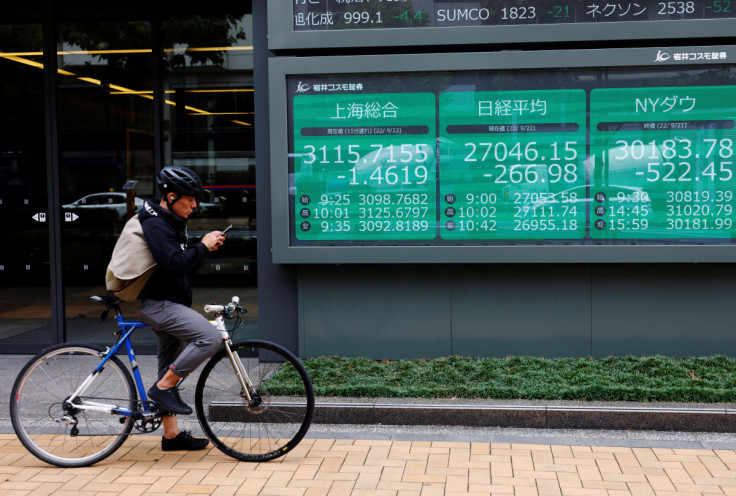Stocks stall as firm Fed reins in China rally
Wall Street was set to tap the brakes on Thursday as upbeat jobs data after a firm message from the Fed that it won't be cutting interest rates any time soon offset China's latest reopening plans.

Wall Street was set to tap the brakes on Thursday as upbeat jobs data after a firm message from the Fed that it won't be cutting interest rates any time soon offset China's latest reopening plans.
News that China's mainland border with Hong Kong will be reopened after three years had sent Asian-Pacific shares outside Japan to a four-month high overnight, but with both the dollar and bond market borrowing costs creeping up, Europe couldn't keep up.
The pan-European STOXX was fractionally lower after gaining more than 3% in its first three sessions of 2023 while Wall Street futures pointed to modest falls there too. [.N]
London's FTSE did manage a respectable 0.5% rise as better-than-expected numbers from retail giant Next lifted the entire European sector, but it barely made up for a groggy Frankfurt and Paris. [.EU][.N]
"Everyone expected a hawkish message from the Fed and that is what we got," said MUFG's Head of Research for Global Markets EMEA, Derek Halpenny.
"Really it's now about payrolls (U.S. jobs data) tomorrow," he added, explaining that the labour market will be a big factor in how high inflation remains this year.
"A strong print tomorrow and I think you are going to get a fairly rapid repricing for a 50 bps hikes at the next (Fed) meeting."
Investors were already digesting their pre-payrolls appetiser, the ADP National Employment report, which showed the private sector added more jobs in December than a month ago. It came a day after a moderate fall in U.S. job openings too.
Markets are clearly being tugged in different directions though. Amazon.com jumped 2.8% in premarket trading after it had announced plans to layoff more than 18,000 staff.
China too has abruptly dropped ultra-strict curbs on travel and activity, fanning hopes that once the infection waves pass, its giant economic motors can start firing again and offset the slowdowns in other parts of the world.
Thursday's biggest Asian gains included E-commerce and consumer stocks in Hong Kong thanks to the China mainland border news, which drove the Hang Seng to a six-month high.
The yuan also rose about 0.2% to 6.8750 to a four-month high and also supported other currencies such as the Thai baht which, as Thailand is now expected to see a mass return of Chinese holidaymakers, has surged nearly 14% in less than 3 months.
"China reopening has a big impact ... worldwide," said Joanne Goh, an investment strategist at DBS Bank in Singapore, since it not only spurs tourism and consumption but can ease some of the supply-chain crunches seen during 2022.
"There will be hiccups on the way," Goh said, during an outlook presentation to reporters. "We give it six months adjusting to the process. But we don't think it's reversible."
RATES WARNING
China's central bank also said overnight it will step up financing support to spur domestic consumption and key investment projects and support a stable real estate market.
It has eased an unofficial ban on Australian coal imports in recent days as well and the Australian dollar made a three-week high overnight just below $0.69. It last bought $0.6818.
Oil rebounded too after posting the biggest two-day loss for the start of a year in three decades. [O/R]
Brent crude was last up $1.49, or 1.9%, to $79.32 a barrel, while U.S. West Texas Intermediate crude futures gained $1.40 to $74.27 an unexpected shutdown of a major U.S. fuel pipeline also lifted prices. [O/R]
"This morning's rebound is due to the shutdown of Line 3 of the Colonial pipeline," said Tamas Varga of oil broker PVM. "There is no doubt that the prevailing trend is down," though he added. "It is a bear market".
Wall Street futures were down 0.3% after the jobs data. Minutes from the Federal Reserve's December meeting, published on Wednesday, had contained a pointed rebuttal against rate cuts bets that traders have priced in for late in the year.
Fed committee members noted that "unwarranted easing in financial conditions" would complicate efforts to restore price stability.
"Translating Fed speak, this is a warning to markets, that being too optimistic may ironically backfire," said Vishnu Varathan, Mizuho Bank's head of economics in Singapore.
"That is, insofar that premature rate cut bets drive looser financial conditions, the Fed may have to tighten even more to compensate."
Fed funds futures pricing shows traders think the benchmark U.S. interest rate will peak just below 5% in May or June, before being cut back a little bit in the second half of 2023.
Benchmark 10-year Treasury yields - which move inverse to price - were fractionally higher at 3.74% in Europe but still down nearly 10 basis points (bps)on the week.
Germany's 10-year government bond yield was last up 3 bps at 2.32%. It too though has fallen nearly 25 bps this week after closing out 2022 at its highest level since 2011. [GVD/EUR]
Preliminary inflation data from Germany, France and Spain all showed this week that consumer prices rose at a slower pace in December than November, following an easing in energy price rises.
In currency markets, the dollar has been wobbly as investors navigate between the Fed's hawkish tone and the support for riskier currencies driven by China's reopening.
It was pinning down the yen again at 133.45 per dollar, cutting the wagers that Japan's ultra-easy monetary policy will be finally tightened this year.
In Europe, unseasonably warm weather has disappointed skiers but been a boon for a euro basking in falling gas prices. Benchmark Dutch gas prices fell to 14-month lows overnight and the euro was down 0.3% at $1.0568. [FRX/]
Copyright Thomson Reuters. All rights reserved.





















